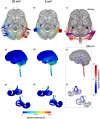Impact of galvanic vestibular stimulation electrode current density on brain current flow patterns: Does electrode size matter?
- PMID: 36735686
- PMCID: PMC9897567
- DOI: 10.1371/journal.pone.0273883
Impact of galvanic vestibular stimulation electrode current density on brain current flow patterns: Does electrode size matter?
Abstract
Background: Galvanic vestibular stimulation (GVS) uses at least one electrode placed on the mastoid process with one or multiple placed over other head areas to stimulate the vestibular system. The exact electrode size used is not given much importance in the literature and has not been reported in several studies. In a previous study, we compared the clinical effects of using different electrode sizes (3 cm2 and 35 cm2) with placebo but with the same injected current, on postural control. We observed significant improvement using the smaller size electrode but not with the bigger size electrode. The goal of this study was to simulate the current flow patterns with the intent to shed light and potentially explain the experimental outcome.
Methods: We used an ultra-high-resolution structural dataset and developed a model to simulate the application of different electrode sizes. We considered current flow in the brain and in the vestibular labyrinth.
Results: Our simulation results verified the focality increase using smaller electrodes that we postulated as the main reason for our clinical effect. The use of smaller size electrodes in combination with the montage employed also result in higher induced electric field (E-field) in the brain.
Conclusions: Electrode size and related current density is a critical parameter to characterize any GVS administration as the choice impacts the induced E-field. It is evident that the higher induced E-field likely contributed to the clinical outcome reported in our prior study.
Copyright: © 2023 Truong et al. This is an open access article distributed under the terms of the Creative Commons Attribution License, which permits unrestricted use, distribution, and reproduction in any medium, provided the original author and source are credited.
Conflict of interest statement
DQT, AG, and AD are employees of Soterix Medical. The remaining authors declare that the research was conducted in the absence of any commercial or financial relationships that could be construed as a potential conflict of interest. This does not alter our adherence to PLOS ONE policies on sharing data and materials.
Figures


References
Publication types
MeSH terms
LinkOut - more resources
Full Text Sources

